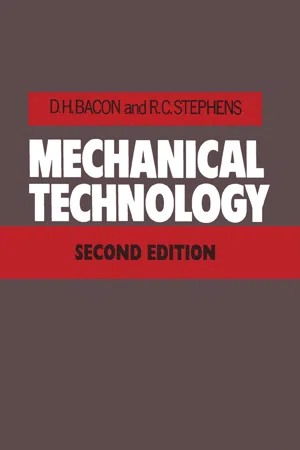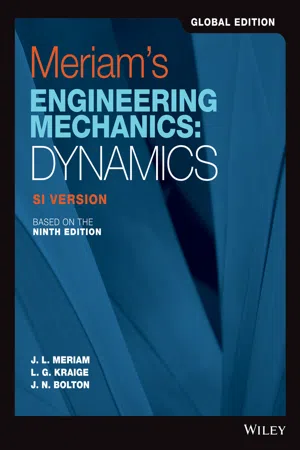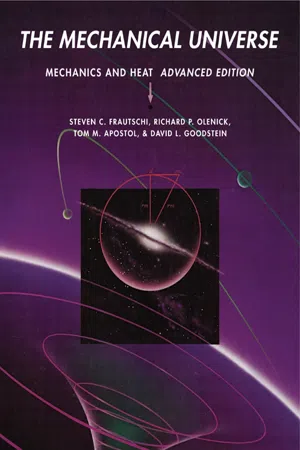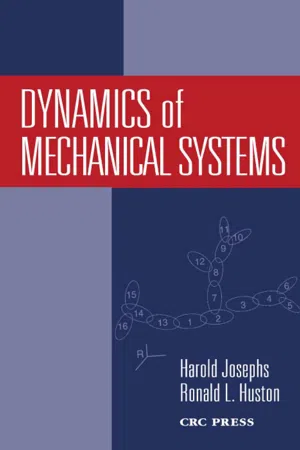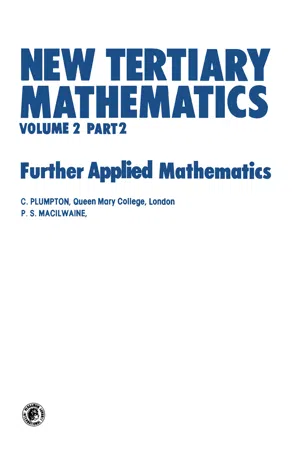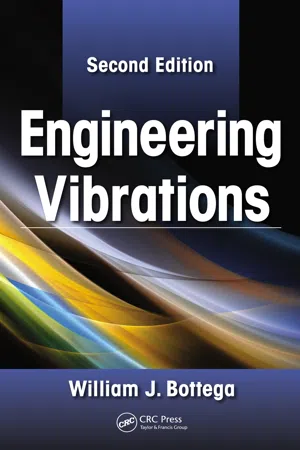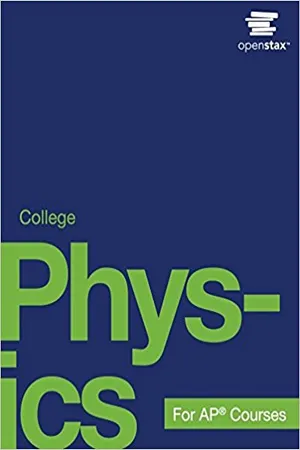Physics
Angular Impulse
Angular impulse is a measure of the rotational motion of an object, calculated as the product of the torque applied to an object and the time over which it is applied. It represents the change in angular momentum of the object and is important in understanding how forces cause rotational motion.
Written by Perlego with AI-assistance
Related key terms
1 of 5
10 Key excerpts on "Angular Impulse"
- eBook - PDF
- D H Bacon, R. C. Stephens(Authors)
- 2013(Publication Date)
- Newnes(Publisher)
The Angular Impulse of a constant torque T acting for a time t is the product Tt. If this causes a body of moment of inertia / to change its angular velocity from ω ί to ω 2 , then T= Ioc = Ι(ω 2 — ω ι )/ί, or Τΐ = Ι(ω 2 -ω ι ) (10.27) i.e. Angular Impulse = change of angular momentum 136 MECHANICAL TECHNOLOGY 10.13 Angular work, power and kinetic energy If a constant torque T moves through an angle 0, the work done = ΤΘ. If the torque is variable, work done = ΣΤδθ, which is represented by the area under a torque-angle graph. When the torque is a function of 0, however, this may be expressed in the form work done = /(0)d0 (10.28) If a constant torque T moves with an angular velocity ω, then power Ρ=Τω Referring to Figure 10.4, kinetic energy of particle of mass dm=^dm(col) 2 (10.29) ω total kinetic energy of body = —-Jdm.Z 2 (10.30) =έ/ 0 ω 2 Alternatively, since I 0 = I G + mh 2 (see Appendix A), kinetic energy of body=^I G eo 2 +mh 2 ω 2 = jI G a> 2 +mv 2 (10.31) The total kinetic energy is therefore the kinetic energy due to rotation about G together with the kinetic energy due to the linear velocity of G. 10.14 Equivalent mass of a rotating body Figure 10.5 10.15 Acceleration of geared systems It is sometimes convenient to treat combined linear and angular motion as an equivalent linear problem, the angular eflfects being allowed for by an equivalent mass added to the actual mass of the body. Consider the body of mass m shown in Figure 10.5. Let a tangential force F be applied at radius r causing an angular acceleration a. Fr = / 0 a = m/c 2 -Then * i k 2 F = m[ -j )a (10.32) The quantity ml -^ I is the equivalent mass of the rotating body referred to the line of action of F. Figure 10.6 shows two gear wheels A and B with moments of inertia I a and l h respectively, having a speed ratio —-= n. If a torque T is applied to - eBook - PDF
Meriam's Engineering Mechanics
Dynamics
- L. G. Kraige, J. N. Bolton(Authors)
- 2020(Publication Date)
- Wiley(Publisher)
Angular momentum is the moment of linear momentum and must not be con-fused with linear momentum. In SI units, angular momentum has the units kg ∙ (m ∕ s) ∙ m = kg ∙ m 2 ∕ s = N ∙ m ∙ s . In the U.S. customary system, angular momen-tum has the units [lb ∕ (ft ∕ sec 2 )][ft ∕ sec][ft] = lb-ft-sec. Rate of Change of Angular Momentum We are now ready to relate the moment of the forces acting on the particle P to its angular momentum. If Σ F represents the resultant of all forces acting on the par-ticle P of Fig. 3 ∕ 14 , the moment M O about the origin O is the vector cross product Σ M O = r × Σ F = r × m v ˙ H O = r × m v A H O = r × m v P P r r O z y x m v View in plane A ( a ) ( b ) H O = mvr sin u1D703 r sin u1D703 m v u1D703 u1D703 u1D703 FIGURE 3/14 mv y mv x mv z m z z y O y x x r FIGURE 3/15 94 CHAPTER 3 Kinetics of Particles where Newton’s second law Σ F = m v ˙ has been substituted. We now differentiate Eq. 3 ∕ 29 with time, using the rule for the differentiation of a cross product (see item 9, Art. C ∕ 7, Appendix C) and obtain H ˙ O = r ˙ × m v + r × m v ˙ = v × m v + r × m v ˙ The term v × m v is zero since the cross product of parallel vectors is identically zero. Substitution into the expression for Σ M O gives Σ M O = H ˙ O (3 ∕ 31) Equation 3 ∕ 31 states that the moment about the fixed point O of all forces acting on m equals the time rate of change of angular momentum of m about O . This relation, particularly when extended to a system of particles, rigid or nonrigid, provides one of the most powerful tools of analysis in dynamics. Equation 3 ∕ 31 is a vector equation with scalar components Σ M O x = H ˙ O x uni00A0 uni00A0 Σ M O y = H ˙ O y uni00A0 uni00A0 Σ M O z = H ˙ O z (3 ∕ 32) The Angular Impulse-Momentum Principle Equation 3 ∕ 31 gives the instantaneous relation between the moment and the time rate of change of angular momentum. - eBook - PDF
- Richard C. Hill, Kirstie Plantenberg(Authors)
- 2013(Publication Date)
- SDC Publications(Publisher)
Note that even though the Angular Impulse and angular momentum may be determined for a moving reference frame (i.e. O is arbitrary), the Angular Impulse-momentum principle only applies for an inertial reference frame (i.e. O is fixed). Conceptual Dynamics Kinetics: Chapter 10 – Rigid-Body Impulse and Momentum 10 - 7 Angular Impulse-momentum principle for a system of particles: 2 1 ,2 ,1 ,2 ,1 ( ) ( ) O O t O Oi Oi i i i i i i t dt m m J H M H H r v r v (10.1-9) H Oi,1 ,H Oi,2 = angular momentum at state 1 and state 2 of the i th particle, respectively H O = total change in angular momentum for the system with respect to O J O = external Angular Impulse applied to the system with respect to O m i = mass of the i th particle M O = resultant moment acting on the system r i = position of the i th particle with respect to O t = time v i,1 ,v i,2 = velocity at state 1 and state 2 of the i th particle, respectively Conceptual Example 10.1-1 A horizontal force is applied over a small interval of time to the system of particles in the situations shown. Rank the magnitude of the change in linear velocity of each body’s mass center from before the application of the impulse to after the removal of the impulse. Then rank the magnitude of the change in angular velocity of each body from before the application of the impulse to after the removal of the impulse. Linear velocity Greatest _____ Next ______ Next ______ Least ______ Angular velocity Greatest _____ Next ______ Next ______ Least ______ Conceptual Dynamics Kinetics: Chapter 10 – Rigid-Body Impulse and Momentum 10 - 8 Conceptual Example 10.1-2 A large force in the x-direction is applied to the system of particles shown over a small interval of time. Following the removal of the force, how do you expect the system to move? a) Translate up (pos y) and to the right (pos x) without rotating. - eBook - PDF
The Mechanical Universe
Mechanics and Heat, Advanced Edition
- Steven C. Frautschi, Richard P. Olenick, Tom M. Apostol, David L. Goodstein(Authors)
- 2008(Publication Date)
- Cambridge University Press(Publisher)
(13.8) I By analogy with the relation between impulse and momentum, the quantity on the left-hand side is sometimes called Angular Impulse, and the equation reads: The Angular Impulse equals the change in angular momentum. 13.3 ANGULAR MOMENTUM CONSERVATION As with its close relative, momentum, there are many circumstances in which the angular momentum of a system is conserved. First of all, the external torques applied to a body may vanish or cancel. In this case 13.3 ANGULAR MOMENTUM CONSERVATION 339 su L = const. (13.9) (13.10) Because L is a vector, Eq. (13.10) is really three separate conservation laws for the components L x , L v , and L 2 . Second, even if external forces and torques are present, they may have a negligible effect during the brief duration of a collision or explosion. In this case the overall momentum and angular momentum of a system may be conserved in the collision or explosion: P, = const, L, = const, (13.11) even though strong internal impulses change the p,- and L,- of individual particles. For example, friction supplies both an external force and a torque to a rolling billiard ball, eventually bringing it to rest. But friction can be neglected in the collision of two billiard balls - both momentum and angular momentum are conserved. Third, if something exerts an external torque on a system, then the system exerts an external but opposite torque on that something, as we saw in the previous section. If we include that external thing as part of a new, larger system, and that external thing is not subject to other torques, then the external torque on the whole system vanishes, so its angular momentum will be conserved. For example, in a classic lecture demonstration, a student stands on a turntable holding a bicycle wheel in the horizontal plane. When the student applies a torque to the bicycle wheel, it applies a countertorque to him. - eBook - PDF
- Harold Josephs, Ronald Huston(Authors)
- 2002(Publication Date)
- CRC Press(Publisher)
It is often triangular. The magnitude of the impulse is then the average of the impact force magnitude multiplied by the impact time t * . The direction of the impulse is the same as that of the force. The dimensions of an impulse are thus force–time. I F * = ∫ D O t dt 280 Dynamics of Mechanical Systems On occasion, colliding bodies will be rotating so that the impact creates a force system that may be represented by a single force F passing through a point Q in the impact force region together with a couple with torque M Q . The torque can then produce an Angular Impulse J Q which, analogous to Eq. (9.2.1), is defined as: (9.2.2) Finally, if an impact occurs during a time interval ( t 1 , t 2 ) the impulse system may be represented by the linear impulse I passing through a point Q together with an Angular Impulse J Q , where I and J Q are: (9.2.3) where as before, M Q is the moment of the impact forces about Q . 9.3 Linear Momentum Consider a particle P with mass m and velocity v in a reference frame R as in Figure 9.3.1. The linear momentum L P of P in R is defined as: (9.3.1) Observe that L P has the dimensions of mass–velocity or mass–length per unit time. Next, consider a set S of N particles P i ( i = 1,…, N ) having masses m i and velocities in a reference frame R as in Figure 9.3.2. Then, the linear momentum L S of S in R is defined as: (9.3.2) FIGURE 9.2.1 Time profile of the magnitude of a typical impact force. J M Q D Q O t dt = ∫ I F J M = = ∫ ∫ dt dt t t Q Q t t 1 2 1 2 and L v P D m = v P i L L v S P i P i N i N i i m = = = = ∑ ∑ ∆ 1 1 Principles of Impulse and Momentum 281 Finally, consider a rigid body B with mass m and mass center G moving in a reference frame R as in Figure 9.3.3. Consider B to be composed of N particles P i ( i = 1,…, N ) with masses m i . - eBook - PDF
New Tertiary Mathematics
Further Applied Mathematics
- C. Plumpton, P. S. W. Macliwaine(Authors)
- 2016(Publication Date)
- Pergamon(Publisher)
Thus: Force-Acceleration Work-Energy Impulse-Momentum For a particle moving in a straight line P = m'x P dx = Change in jmv 2 (Change in kinetic energy) P dr = Change in mv (Change in linear momentum) For a rigid body rotating about an axis L dö = Change in i/o 2 (Change in kinetic energy) L dr = Change in 10 ' (Change in angular momentum about the axis) Note on dimensions. It is of interest at this point to consider the dimensions of the quantities with which we are concerned in this chapter. Angles (measured in circular measure) have zero dimensions. Angular speed has dimensions T _ 1 . Angular acceleration has dimensions T~ 2 . Moment of inertia has dimensions ML 2 . Kinetic energy. The quantity expressed by either mv 2 or IQ 2 has dimensions ML 2 T -2 . Impulse and linear momentum (mv) have dimensions MLT -1 . Impulsive couple and angular momentum (16) have dimensions ML 2 T _1 . Ch. 10 §10:7 INSTANTANEOUS CENTRE OF ROTATION 381 10:7 THE MOTION OF A LAMINA IN ITS OWN PLANE—INSTANTANEOUS CENTRE OF ROTATION In Fig. 10.15, P l5 P 2 , P 3 are three particles of a rigid lamina which is free to move in its own plane and AB is an arbitrary line, fixed in the frame of reference, in the plane of the lamina. The angle between AB and P x P 2 is 0, the angle between AB and P x P 3 is (/>, and the angle between P { P 3 and P X P 2 is a, each angle being measured in the anticlockwise sense from the first-named direction. FIG. 10.15. We have, in this case, (/> — 0 = 2n — cc, and from the definition of a rigid body, a is constant (In general, for all positions of P^ P 2 , P3 relative to the axis, (/> — 0 is constant.) =>(j) = 0 and $ = 0. Similarly it can be shown that 0 and 0 are each independent of the choice of the fixed direction AB. It follows that all lines of the lamina have the same angular speed and the same angular acceleration and these quantities are respectively defined as the angular speed and the angular acceleration of the lamina. - No longer available |Learn more
- Ping YI, Jun LIU, Feng JIANG(Authors)
- 2022(Publication Date)
- EDP Sciences(Publisher)
Since v ¼ 0 at t ¼ 0, integrating and solving yields Z v 2 0 dv ¼ Z 3 0 0:625 5 þ t 2 dt ) v 2 ¼ 15 m/s RETHINK: The principle of Angular Impulse and momentum in solution 1 directly relates force, time and (angular) velocity. Solution 2 first get the (angular) accel- eration using the equation of motion, then using integration to get (angular) velocity. Therefore, solution 1 is much easier here than solution 2. 10.3 Principle of Impulse and Momentum for a System of Particles Consider a system of n particles within an enclosed region in space, as shown in figure 10.10. Applying the principle of linear impulse and momentum to the arbi- trary i-th particle, which is subjected to an internal force f i and an external force F i , we obtain m i v i1 þ Z t 2 t 1 F i þ f i ð Þdt ¼ m i v i2 ð10:13Þ Kinetics: Impulse and Momentum 421 Applying this principle to each of the other particles of the system, similar equations would be written. Then for the whole system, all n equations vectorially added together gives X m i v i1 þ X Z t 2 t 1 F i dt þ X Z t 2 t 1 f i dt ¼ X m i v i2 ð10:14Þ The sum of linear impulses of all the internal forces, P R t 2 t 1 f i dt , will be zero, since internal forces always occur in equal but opposite collinear pairs and then their linear impulses cancel out. Therefore, equation (10.14) becomes X m i v i1 þ X Z t 2 t 1 F i dt ¼ X m i v i2 ð10:15Þ This is the principle of linear impulse and momentum for a system of particles. It states that the initial linear momentum of the system of particles plus the linear impulses of all the external forces applied to the system from t 1 to t 2 equals the system’s final linear momentum. From the principle of Angular Impulse and momentum for a particle, expressed as equation (10.12), we can write the following equation for the i-th particle, H Oi1 þ Z t 2 t 1 M O F i ð Þdt þ Z t 2 t 1 M O f i ð Þdt ¼ H Oi2 ð10:16Þ Consider each of the other particles of the system and similar equations can be written. - eBook - PDF
- William J. Bottega(Author)
- 2014(Publication Date)
- CRC Press(Publisher)
44 Engineering Vibrations 2 1 t t F dt ≡ (1.98) is the linear impulse imparted by the force F over the time interval Δ t = t 2 − t 1 , and ( ) ( ) t mv t ℘ ≡ (1.99) is the linear momentum of the particle at time t . Thus, a linear impulse that acts on a particle for a given duration produces a change in linear momentum of that particle during that time period. Conservation of Linear Momentum If the linear impulse vanishes over a given time interval, Eqs. (1.96) and (1.97) reduce to the statements 2 1 ( ) ( ) mv t mv t = (1.100) or constant mv ℘= = (1.101) When this occurs, the linear momentum is said to be conserved over the given time interval. Angular Impulse and Momentum In the previous section we established an integral, over time, of Newton’s Second Law that led to the principle of linear impulse-momentum. We next establish the rotational analog of that principle. Let us form the vector cross product of Newton’s Second Law, Eq. (1.83), with the position vector of a particle at a given instant. Doing this results in the relation O O M H = (1.102) where O M r F = × (1.103) is the moment of the applied force about an axis through the origin, and O H r mv = × (1.104) is referred to as the angular momentum , or moment of momentum, of the particle about O . Let us next multiply Eq. (1.102) by the differential time increment dt , and integrate the re-sulting expression between two instants in time, t 1 and t 2 , during the particle’s motion. This results in the statement of the Principle of Angular Impulse-Momentum , [ ] [ ] 2 2 1 1 t t t t t t r F dt r mv r mv = = × = × − × (1.105) 1 │ Preliminaries 45 O F Figure 1.38 Central force motion. or, equivalently, O O H = Δ (1.106) where 2 2 1 1 t t O O t t M dt r F dt ≡ = × (1.107) is the Angular Impulse about an axis through O , imparted by the force F , or simply the Angular Impulse about O . - eBook - PDF
- Paul Peter Urone, Roger Hinrichs(Authors)
- 2012(Publication Date)
- Openstax(Publisher)
The direction of the torque is thus the same as that of the angular momentum it produces. • The gyroscope precesses around a vertical axis, since the torque is always horizontal and perpendicular to L . If the gyroscope is not spinning, it acquires angular momentum in the direction of the torque ( L = ΔL ), and it rotates about a horizontal axis, falling over just as we would expect. • Earth itself acts like a gigantic gyroscope. Its angular momentum is along its axis and points at Polaris, the North Star. Conceptual Questions 10.1 Angular Acceleration 1. Analogies exist between rotational and translational physical quantities. Identify the rotational term analogous to each of the following: acceleration, force, mass, work, translational kinetic energy, linear momentum, impulse. 2. Explain why centripetal acceleration changes the direction of velocity in circular motion but not its magnitude. 3. In circular motion, a tangential acceleration can change the magnitude of the velocity but not its direction. Explain your answer. 4. Suppose a piece of food is on the edge of a rotating microwave oven plate. Does it experience nonzero tangential acceleration, centripetal acceleration, or both when: (a) The plate starts to spin? (b) The plate rotates at constant angular velocity? (c) The plate slows to a halt? 10.3 Dynamics of Rotational Motion: Rotational Inertia 5. The moment of inertia of a long rod spun around an axis through one end perpendicular to its length is ML 2 /3 . Why is this moment of inertia greater than it would be if you spun a point mass M at the location of the center of mass of the rod (at L / 2 )? (That would be ML 2 /4 .) 6. Why is the moment of inertia of a hoop that has a mass M and a radius R greater than the moment of inertia of a disk that has the same mass and radius? Why is the moment of inertia of a spherical shell that has a mass M and a radius R greater than that of a solid sphere that has the same mass and radius? 7. - Raymond Serway, John Jewett(Authors)
- 2018(Publication Date)
- Cengage Learning EMEA(Publisher)
Let’s see if a similar statement can be made for rotational motion. The total angular momen- tum of a system of particles about some axis is defined as the vector sum of the angular momenta of the individual particles: L S tot 5 L S 1 1 L S 2 1 Á 1 L S n 5 o i L S i where the vector sum is over all n particles in the system. Differentiating this equation with respect to time gives d L S tot dt 5 o i d L S i dt 5 o i t S i where we have used Equation 11.13 to replace the time rate of change of the angu- lar momentum of each particle with the net torque on the particle. The torques acting on the individual particles of the system are those associ- ated with internal forces between particles and those associated with external forces. The net torque associated with all internal forces, however, is zero. Recall that Newton’s third law tells us that internal forces between particles of the system occur in pairs that are equal in magnitude and opposite in direction. If we assume these forces lie along the line of separation of each pair of particles, the total torque around some axis passing through an origin O due to each action–reaction force pair is zero (that is, the moment arm d from O to the line of action of the forces is equal for both particles, and the forces are in opposite directions). In the summation, therefore, the net internal torque is zero. We conclude that the total angular momentum of a system can vary with time only if a net external torque is acting on the system: o t S ext 5 d L S tot dt (11.15) This equation is indeed the rotational analog of o F S ext 5 d p S tot y dt for a system of particles. Equation 11.15 is the mathematical representation of the angular momentum version of the nonisolated system model. If a system is nonisolated in the sense that there is a net external torque on it, the net external torque on the system is equal to the time rate of change of the angular momentum of the system.
Index pages curate the most relevant extracts from our library of academic textbooks. They’ve been created using an in-house natural language model (NLM), each adding context and meaning to key research topics.
